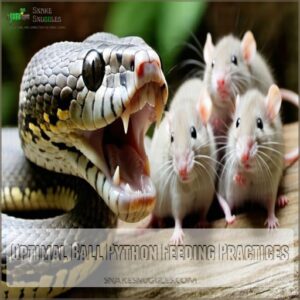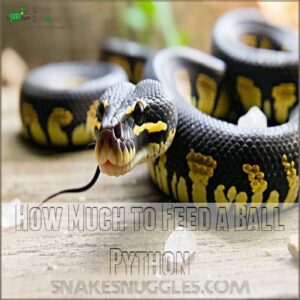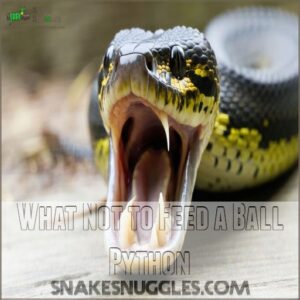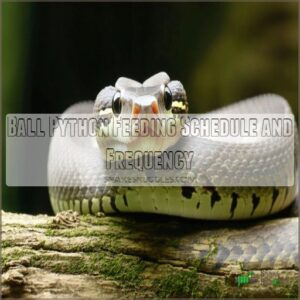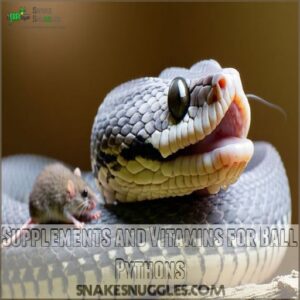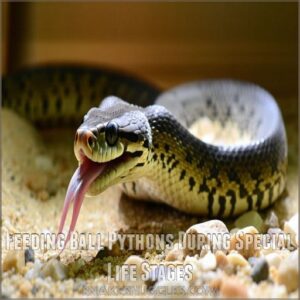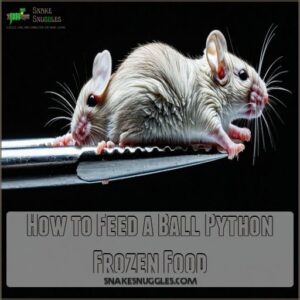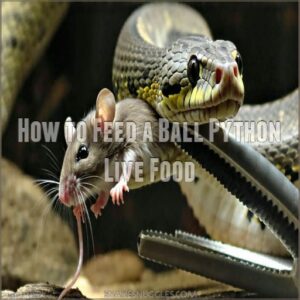This site is supported by our readers. We may earn a commission, at no cost to you, if you purchase through links.
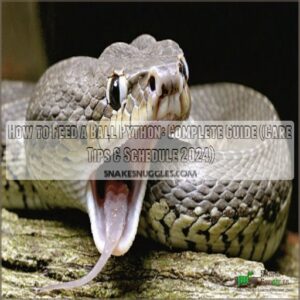
Thaw the rodent completely in warm water, not the microwave. The prey should be roughly the size of your snake’s head.
Feeding frequency depends on age and size—babies eat more often than adults. Always provide fresh water. Remember, proper hydration is key to your snake’s overall health.
Overfeeding can cause problems, so stick to a schedule. Want to master the art of ball python feeding and guarantee your snake thrives? We’ll explore specific feeding charts and address picky eaters in the sections that follow.
Table Of Contents
- Key Takeaways
- Optimal Ball Python Feeding Practices
- How Much to Feed a Ball Python
- Choosing The Right Food for Ball Pythons
- Ball Python Feeding Schedule and Frequency
- Supplements and Vitamins for Ball Pythons
- Feeding Ball Pythons During Special Life Stages
- Advanced Ball Python Feeding Techniques
- Frequently Asked Questions (FAQs)
- Should you feed ball pythons in their cage?
- How much should my ball python eat?
- How do you know if a ball python is hungry?
- Should I feed my ball python at night or day?
- Can ball pythons eat live prey safely?
- How long should feeding sessions last?
- What times are best to feed ball pythons?
- How can I encourage my python to eat?
- What to do if my python refuses food?
- Conclusion
Key Takeaways
- You’ll want to feed your ball python appropriately sized frozen-thawed rodents and avoid live prey to prevent injuries.
- Thaw the prey in warm water, not the microwave, and use tongs to safely offer it to your snake.
- Stick to a feeding schedule based on your snake’s age and size, ensuring you don’t overfeed and risk obesity.
- Keep your python hydrated with fresh water, and monitor humidity levels to support its overall health.
Optimal Ball Python Feeding Practices
You’ll need to master a few essential feeding techniques to keep your ball python healthy and thriving in captivity.
Your success depends on following a proper feeding schedule.
selecting the right prey size, and using safe handling methods during mealtimes.
Feeding Methods and Best Practices
For your ball python’s diet, go with frozen-thawed rodents to avoid parasites.
Thaw these in warm water, not the microwave, then use tongs to offer prey safely.
This method guarantees your snake’s health and reduces stress during feeding.
After a meal, let your python digest undisturbed in its enclosure, promoting good health and digestion.
Common Feeding Mistakes to Avoid
When feeding a ball python, don’t fall into common traps. Here’s what to watch out for:
- Overfeeding: Can lead to obesity, reducing lifespan.
- Improper thawing: Thaw prey correctly to avoid health risks.
- Handling after feeding: Wait 72 hours to prevent regurgitation.
- Wrong prey size: Must match head size—not too big!
- Feeding live prey: Risks injury to your snake.
Importance of Proper Hydration
Though they’re not big on gulping water, keeping your ball python hydrated is essential. Dehydration signs like wrinkled skin can sneak up on you. They might soak for a drink, too. Remember, water impacts feeding. Keep their water dish fresh to meet their hydration needs.
Make certain water sources are clean and humidity levels stay right.
| Dehydration Signs | Water Sources | Humidity Levels |
|---|---|---|
| Wrinkled Skin | Clean Bowl | 50-60% |
| Dry Eyes | Soaking | Maintainitorl |
| Lethargy | Daily Change | Adjust as Needed |
| Lack of Appetite | Always Available | Monitor Regularly |
| Shedding Issues | Mist Regularly | Check Often |
How Much to Feed a Ball Python
Mastering ball python feeding is key to their health. We’ve covered best feeding practices; now, let’s figure out how much to feed your scaly friend. It’s all about getting the portion size right. Think of it like Goldilocks and the Three Bears—too much, too little, or just right. For more information on optimal feeding schedules, consider the age and weight of your ball python to adjust its feeding frequency.
- Prey size: Match the prey to your snake’s body. A good rule of thumb is 1 to 1.25 times the width of its thickest part.
- Feeding charts: Use a feeding chart as a guideline based on your snake’s age and weight. These are readily available online.
- Weight monitoring: Regularly weigh your ball python to track growth. This helps you adjust feeding amounts as needed.
- Growth stages: Remember, feeding frequency changes as your snake grows from hatchling to adult. A baby python needs more frequent meals than a mature adult.
Overfeeding leads to obesity and other health problems. Underfeeding stunts growth. Consistent monitoring prevents both extremes. You want your python to thrive, not just survive!
Choosing The Right Food for Ball Pythons
When choosing the right food for your ball python, stick to a diet primarily made up of rodents like mice and rats, which offer essential nutrients.
Avoid feeding them inappropriate foods like eggs, fish, or large mammals to safeguard their health and prevent digestive issues.
Suitable Prey and Dietary Considerations
Ball python diet hinges on prey variety and nutritional value.
Think mice, rats, and occasional chicks for a balanced menu.
Each meal should fit your snake’s midsection snugly.
You can buy frozen mice for ball pythons from quality frozen mice suppliers.
Frozen mice for ball pythons are a safe, nutritious choice.
Catering to picky eaters? Try different sizes or scents to entice their appetite, ensuring food safety and good health.
What Not to Feed a Ball Python
Feeding your ball python the right foods keeps it healthy and thriving.
Steer clear of wild rodents—they can carry nasty parasites.
Skip feeding amphibians, fish, or anything too big for your snake’s size. Such foods can harm its health or cause serious issues.
Stick to safe choices for your ball python’s diet, and avoid toxic foods. Avoid wild rodents.
Recommended Prey Size and Types
When feeding your ball python, focus on prey variety. Stick with rats or mice, considering safety and ease.
Choose frozen-thawed options for convenience and safety, ensuring prey weight doesn’t overwhelm your snake’s midsection size.
With a little practice, you’ll nail picking the right size.
Remember, frozen-thawed mice or rats work wonders for predictable feeding sessions.
Happy feeding, and keep your python’s health a priority!
Ball Python Feeding Schedule and Frequency
Managing your ball python’s feeding schedule involves more than just offering a mouse; it’s about timing and prey size too.
Young pythons eat more often than adults, so make sure you’re adjusting the frequency and portion size as your snake grows.
Feeding Frequency by Age and Weight
You’ve nailed down the right food; now it’s time to get the feeding schedule just right.
Keep an eye on weight gain and growth spurts to tweak meal sizes accordingly.
A hatchling devours every five days, but a mature python can last two weeks between meals.
Your ball python feeding guide guarantees they’re at their best weight!
How Long Can Ball Pythons Go Without Eating
Many ball pythons can handle surprisingly long fasting periods. Don’t panic if your snake skips a meal; several factors can cause food refusal.
- Unexpected shedding
- Temperature fluctuations
- Recent relocation stress
- Underlying health problems
- Simply being a picky eater
Weight loss is a concern, but healthy adults can safely go several weeks without food.
Monitor your snake’s body condition; if you see significant weight loss, contact a vet. Implement refeeding strategies like trying different prey or adjusting the feeding schedule accordingly.
Adjusting Feeding Schedules for Breeding
To nail a ball python feeding schedule during breeding, aim for more frequent meals.
Breeding males need extra nourishment, especially when courting several females.
Make sure breeding females hit 1,500 grams pre-breeding, maintaining a hefty diet. Gravid females require weekly large rats until egg-laying for best health.
This attention helps boost breeding success, making sure your pythons thrive and reproduce efficiently. Breeding success is improved with proper feeding.
Supplements and Vitamins for Ball Pythons
Ensuring your ball python gets all the necessary nutrients is essential, but supplements and vitamins are generally not required if you’re feeding a balanced diet.
However, a sprinkle of calcium or vitamin D3 occasionally can benefit their health, especially if you’re not using UV lighting.
supplements and vitamins are generally unnecessary with a balanced diet.
Do Ball Pythons Need Supplements
Wondering if your ball python needs supplements? Generally, they don’t, as a balanced diet usually provides all necessities. You can find products like ball python calcium powder to help meet their calcium needs.
- Vitamin D3 can help without UVB light.
- Calcium needs may be met naturally or through dusting.
- A multivitamin isn’t typically required.
- Gut loading prey boosts nutrition.
Recommended Supplements and Vitamins
Imagine your ball python as a tiny nutritional diva.
Though they’re not typically needy, offering calcium supplements with Vitamin D3 and occasional multivitamins might help balance their nutritional needs, especially regarding preventing metabolic bone disease more about snake health supplements.
Watch for deficiency signs like weak bones.
Ball python supplements aren’t always required, but if your setup lacks UVB lighting, these additions can make a difference.
Feeding Ball Pythons During Special Life Stages
Feeding ball pythons during special life stages requires careful attention to changes in their dietary needs.
Whether you’re managing the appetite of a breeding male or ensuring a gravid female has enough nutrients,
understanding these unique requirements helps maintain their health and energy.
Feeding a Breeding Male
Male ball pythons need an extra bite during breeding season.
These lively fellows can lose weight with all the effort, so bump up their meals.
Consider visiting a reliable online store like breeding python diet options to make certain you’re meeting their nutritional needs.
Feed every 10 to 14 days, making certain their favorite rats or mice are on the menu.
Keep an eye on any weight wobble to dodge health issues.
Remember, happy males breed better!
Feeding a Breeding Female
Feeding a breeding female ball python requires careful planning.
Her pre-breeding weight is key; aim for at least 1500 grams. Monitor her weight closely.
Ovulation timing influences your feeding strategy.
- She might eat more than usual.
- She might show decreased appetite.
- Offer a large rat weekly, adjusting as needed.
Post-lay feeding will be important. Food refusal is possible; be patient.
Feeding a Gravid Female
After tending to your breeding female ball python, ensuring your gravid female gains the right weight is key.
Her pre-lay diet should include hearty meals like a large rat weekly, addressing important nutritional needs for egg incubation.
Post-lay, she mightn’t eat immediately, but when she does, focus on rebuilding her strength. Adjust feeding frequency based on her ball python diet requirements.
Advanced Ball Python Feeding Techniques
Incorporating advanced feeding techniques for your ball python involves knowing how to offer both frozen and live prey effectively.
Whether you’re dealing with a picky eater or simply aiming to enhance their dietary routine, mastering these techniques can improve your snake’s feeding habits and overall health.
advanced feeding techniques can benefit your ball python.
How to Feed a Ball Python Frozen Food
Thawing frozen food for your ball python isn’t rocket science. Here’s a quick guide to get you going:
- Thaw: Place the frozen mouse in the fridge for a few hours or in warm water for about an hour.
- Check: Make certain it’s completely defrosted.
- Heat: Warm it gently to body temperature.
- Serve: Use tongs to offer it safely.
How to Feed a Ball Python Live Food
Moving from frozen to live food, consider your ball python’s natural hunting skills.
Opt for live prey selection like small mice or rats. Use tongs for safe prey handling.
Regular feeding frequency helps avoid regurgitation.
Watch for ethical concerns; guarantee humane practices. Remember, careful approach guarantees a healthy, happy snake. Feeding ball python this way taps into their instincts.
Tips for Feeding a Picky Ball Python
If your ball python turns up its nose at food, spice things up.
For more specific insights on addressing picky eaters, you must account for their natural diet and nutritional needs, such as offering a variety of prey types, colors, and sizes to stimulate their hunting instincts as discussed in snake food for picky eaters guides on snake nutrition.
Enticing picky eaters might also mean experimenting with prey presentation or offering variety options.
Avoid ball python feeding mistakes by making sure it’s healthy, as sick ball python feeding requires special care.
Frequently Asked Questions (FAQs)
Should you feed ball pythons in their cage?
Feeding ball pythons in their cage works, but use tongs to avoid linking your hand with food.
Some owners prefer a separate feeding space to prevent mess and unwanted behaviors, but it’s up to individual preference.
How much should my ball python eat?
Imagine your ball python with a belt that fits snugly, digesting a meal about the same size.
Juveniles eat every 5-10 days, while adults feast every 10-14 days, ensuring the meal isn’t too large.
How do you know if a ball python is hungry?
Your ball python shows hunger by becoming more active, exploring its enclosure, and focusing on movement outside the tank.
It might strike or tongue-flick frequently in anticipation of food, signaling it’s ready for a meal.
Should I feed my ball python at night or day?
Coincidentally, feeding at night mimics their natural habits, enhancing their sense of security and hunting instincts.
Ball pythons are nocturnal, so offering meals during twilight or evening aligns with their active period, ensuring a smoother feeding process.
Can ball pythons eat live prey safely?
Ball pythons can eat live prey, but it’s risky.
Live prey can injure your snake, so it’s safer to offer pre-killed or frozen-thawed rodents.
Use tongs to present the food and avoid handling for 72 hours after feeding.
How long should feeding sessions last?
Feeding time’s like a quick pit stop, not a marathon. Offer food, and once your snake’s grabbed it, you’re done. No need to linger; a few minutes is plenty.
What times are best to feed ball pythons?
Feed ball pythons in the evening.
These nocturnal hunters feel more comfortable hunting in the dark.
Offering meals after sunset aligns with their instincts, making it the ideal feeding time for your snake.
How can I encourage my python to eat?
Try feeding at dusk, when they’re most active.
Wiggle the prey slightly with tongs to trigger their hunting instincts.
Make sure the prey is appropriately warm and dry, mimicking natural conditions.
Avoid handling them right before feeding.
What to do if my python refuses food?
When your python turns its nose up at food, patience is key.
Check temperature and humidity levels, avoid handling post-meal, and offer food at night.
If refusal persists, consult a vet for underlying health issues.
Conclusion
Finding the right balance between feeding and hydration is key for your ball python’s health, yet it doesn’t have to be intimidating.
You’ve learned how to feed a ball python with precision and care, from understanding proper prey size to maintaining a consistent feeding schedule.
Whether you’re managing dietary needs during special life stages or tackling the challenges of a picky eater, this guide equips you with the essential skills to help your scaly friend thrive confidently.

